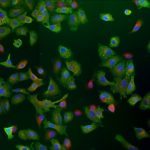Link to Pubmed [PMID] – 31076555
Link to DOI – 10.1073/pnas.1901214116
Proc Natl Acad Sci U S A 2019 May; 116(22): 10968-10977
New therapeutic strategies targeting influenza are actively sought due to limitations in current drugs available. Host-directed therapy is an emerging concept to target host functions involved in pathogen life cycles and/or pathogenesis, rather than pathogen components themselves. From this perspective, we focused on an essential host partner of influenza viruses, the RED-SMU1 splicing complex. Here, we identified two synthetic molecules targeting an α-helix/groove interface essential for RED-SMU1 complex assembly. We solved the structure of the SMU1 N-terminal domain in complex with RED or bound to one of the molecules identified to disrupt this complex. We show that these compounds inhibiting RED-SMU1 interaction also decrease endogenous RED-SMU1 levels and inhibit viral mRNA splicing and viral multiplication, while preserving cell viability. Overall, our data demonstrate the potential of RED-SMU1 destabilizing molecules as an antiviral therapy that could be active against a wide range of influenza viruses and be less prone to drug resistance.


